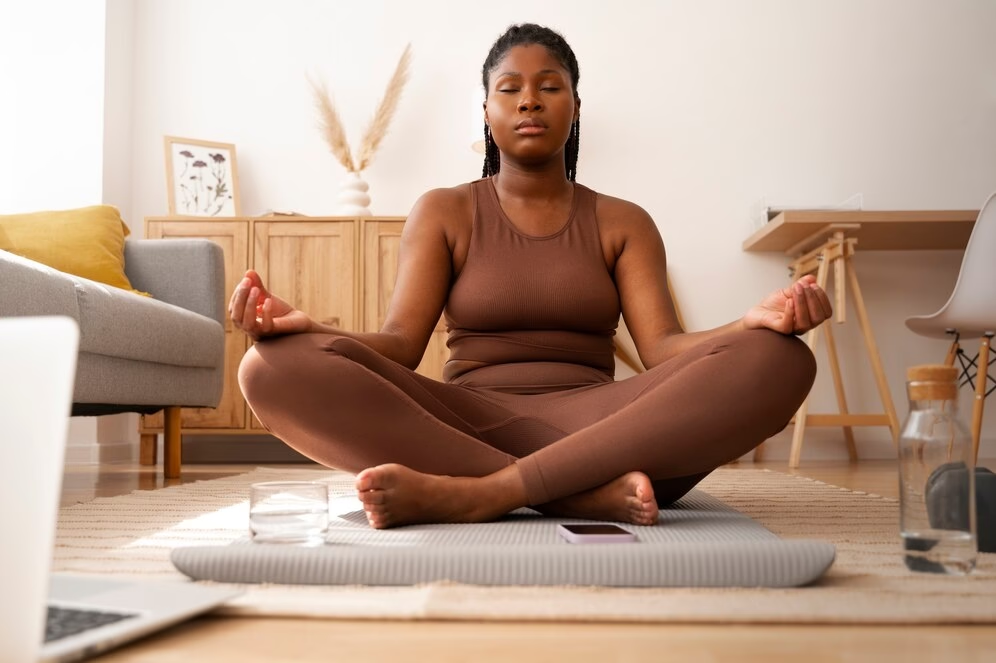“Meditation goes in. Prayer goes out. But they both aim for the same place of union between you and the Divine.” —Lisa Jones
Whenever people hear the term ‘meditation,’ they sometimes immediately link it to wearing robes or having to travel down to India to sleep on cold floors to become a monk in the ashram.
Thankfully, in recent times, people, including myself, have come to understand that it’s not necessarily limited to only praying with mala beads or striking Tibetan singing bowls to enhance the recitation of mantras.
Nor do you need to completely shave your head to perform meditation. These are all just stereotypes attached to the practice of ‘meditation.’.
What is meditation?
Meditation is a practice that dates back thousands of years in Hindu, Buddhist, Zen/Chan, and Taoist traditions, helping individuals cultivate awareness of the present moment, emotional resilience, kindness, and joy even in difficult situations.
Simply put, meditation involves focusing the mind using mental and physical techniques.
It can include practices that:
- Sharpen focus and attention
- Connect to the body and breath
- Develop acceptance of difficult emotions
- Even alter consciousness
Research shows that meditation offers numerous physical and psychological benefits like stress reduction and improved immunity.

Apps to Consider for Practicing
When meditating, a certified teacher oversees the technique. However, nowadays, many apps have been developed to provide easy accessibility to the practice, which does not make use of physically present teachers.
A few such apps include Medito, Insight Timer, Waking Up, Moments of Space, Mindful Glimpses, Healthy Minds, The Way, and Medi Land, which are all professionally tailored to suit individualistic needs.
The awesome thing about meditating is that regardless of age, background, or physical ability, anyone can practice; it’s simple, and it can be easily adapted to fit into any lifestyle.
Types of Meditation in Practice
There are various styles in practice, and picking what makes you comfortable is just as important as the style you want to adopt into your daily practice.
To understand how to do that, it is important to find a practice that meets your needs and requirements. However, before diving deeper into details, let us look at a few styles of meditation.
1. Mindfulness Meditation
As the name suggests, this combines ‘meditating’ with the practice of ‘mindfulness.’ Mindfulness meditation originates from Buddhist teachings and is the most popular and researched form of meditation in the West.
It focuses on your breath or other bodily sensations and helps you cultivate a sense of calm.
By engaging in this style, you pay attention to your thoughts as they pass through your mind; this way, you can slow down raging thoughts and let go of negativity, which enables you to be fully focused on ‘the now’ without judgment.
2. Spiritual Meditation
Spiritual meditation is practiced worldwide across countless religions, cultures, and traditions.
Some use it for stress relief and relaxation, others to clear their minds, and some to awaken and deepen their connection to the divine or something greater than themselves.
A few major religious traditions that incorporate spiritual meditation include:
- Loving-kindness (Metta) meditation in Buddhism
- Marananussati Bhavana (reflection on mortality) in Theravada Buddhism
- The Christian prayer
- Hindu japa mala and mantra meditation
- Sufi dhikr (remembrance of God)

3. Transcendental Meditation
The Transcendental Meditation (TM) technique was founded by Maharishi Mahesh Yogi and refers to a specific practice designed to quiet the mind and induce a state of calm and peace.
This technique involves silently repeating a word or phrase (mantra) in your mind while sitting comfortably with your eyes closed, allowing you to gradually reach a state of inner peace.
TM is best learned from a certified practitioner, ensuring proper guidance and technique.
4. Focused Meditation
This meditation practice helps enhance awareness of the present moment. Rather than trying to empty the mind, this style involves focusing attention on a specific object or physical sensation, such as your breath. It is also known as Focused Attention Meditation (FAM).
Other external influences that can help direct your focus include counting mala beads, staring at a candle flame, and listening to a gong.
5. Visualization Meditation
Visualization technique requires you to focus on enhancing feelings of relaxation, peace, and calmness by actively creating mental images or scenes in your mind. This is done to achieve specific goals and manage stress by visualizing positive images, scenes, or figures.
Although only five are mentioned, there are many more meditation techniques and practices to incorporate into your daily routine, such as mantra meditation, guided and unguided meditation, Zen meditation, yoga meditation, chakra meditation, and metta meditation, to name a few.
You can explore different styles based on your needs. However, if one technique doesn’t resonate with you, feel free to experiment with another until you find what works best.
7 Ways to Build a Consistent Meditating Habit
Although meditation can feel daunting if you’ve never tried it before, it’s fairly straightforward—though it might seem a bit odd at first. Here are a few steps to help you get started.
1. Start Small: For any habit to stick, consistency is key, and meditation is no exception. Starting with just 2–5 minutes a day can help you build consistency, and you can gradually increase the duration as you become more comfortable.
2. Find the Right Time: Choose a time when you’re least distracted or occupied. Experiment with different times of the day to find what works best for you.
3. Create a Mindfulness Space: When meditating, having a dedicated space is important. Find a quiet, comfortable area where you can sit undisturbed and focus.
4. Focus on Your Breath: Close your eyes, take a deep breath, and inhale and exhale mindfully. Your breath becomes your anchor point, helping you expand your awareness and stay present.
5. Try Guided Meditations: There are many meditation apps (some mentioned earlier) where a teacher guides you through the process. This can be especially helpful if you are a beginner who is just starting out.
6. Accept Distractions: It’s natural for your mind to wander—we’re human, after all. When distractions arise, acknowledge them, but don’t dwell on them. Simply let them go and return to your breath.
7. Track Your Progress: Recording your little wins in a journal provides a sense of accomplishment, which helps you stay motivated.

7 Health Benefits of Meditation
Meditation has been tied to many health benefits. Those benefits include
1. Better Sleep
Meditation can improve sleep quality and reduce the effects of insomnia on your daily life and routine. It helps relax your body and ease you into a peaceful state, making it easier to fall asleep.
2. Increased Attention Span
Have you ever experienced trying to read and discovering that you’ve been reading the same line over and over again? I know that I’m not the only one.
Regular meditation enhances focus and concentration, allowing you to stay attentive for longer periods. A studyshowed that individuals who listened to a meditation tape experienced improved attention and accuracy while completing tasks.
3. Lowers Blood Pressure
Meditation supports heart health by reducing strain on the heart and blood vessels, which can help prevent heart disease and lower blood pressure.
4. Improves Memory
Mental clarity and improved memory are benefits of meditating that can help fight age-related memory loss and dementia, which enhances clear thinking, thereby keeping your mind young.
5. Reduces Anxiety
Consistent meditation reduces anxiety levels and can help manage mental health conditions such as social anxiety.
A study found that after eight weeks of mindfulness meditation, participants with anxiety disorders experienced a reduction in anxiety symptoms and improved stress management.
6. Enhances Kindness and Empathy
Meditation helps cultivate positive emotions, fostering kindness and empathy toward yourself and others. Through regular practice, you learn to extend self-compassion internally and project genuine empathy externally.
7. Manages Depression
Regular meditation helps keep negative thoughts at bay, promoting a more positive mindset. It also increases self-awareness, allowing you to acknowledge and process emotions, which can help break cycles of negative thinking and manage depression.
Conclusion: Meditation Is a Journey, Not a Race
Meditation is a powerful self-care habit that anyone can practice without the need for special equipment or costly memberships.
It requires effort and consistency—you may notice small improvements right away, but significant changes take time.
So, if you find meditation challenging at first, don’t be discouraged—stick with it, and the benefits will follow.












